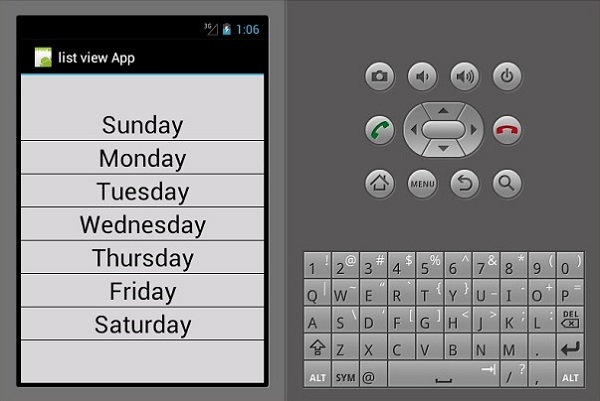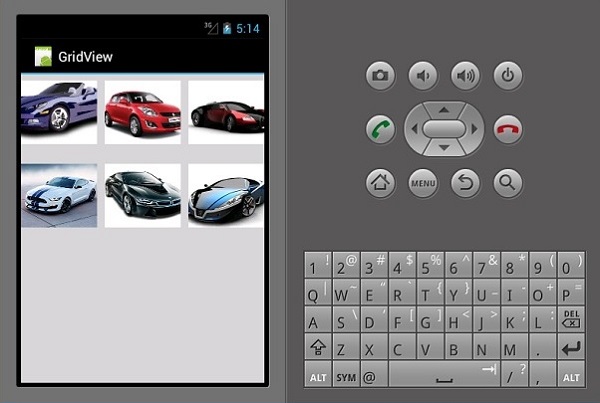
- Xamarin - Home
- Xamarin - Installation
- Xamarin - First Application
- Xamarin - Application Manifest
- Xamarin - Android Resources
- Xamarin - Android Activity Lifecycle
- Xamarin - Permissions
- Xamarin - Building the App GUI
- Xamarin - Menus
- Xamarin - Layouts
- Xamarin - Android Widgets
- Xamarin - Android Dialogs
- Xamarin - Gallery
- Xamarin - Andriod Views
- Xamarin - Multiscreen App
- Xamarin - Deploying Your App
Xamarin - Andriod Views
ListViews
A Listview is a user interface element that displays lists of items that are scrollable.
Binding data to listviews
In this example, you are going to create a listView that displays the days of the week. To start with, let us create a new XML file and name it listViewTemplate.xml.
In listViewTemplate.xml, we add a new textview as shown below.
<?xml version = "1.0" encoding = "utf-8" ?> <TextView xmlns:android = "http://schemas.android.com/apk/res/android" android:id = "@+id/textItem" android:textSize ="20sp" android:layout_width = "fill_parent" android:layout_height = "wrap_content"/>
Next, go to Main.axml and create a new listview inside the Linear Layout.
<ListView android:minWidth="25px" android:minHeight="25px" android:layout_width="match_parent" android:layout_height="match_parent" android:id="@+id/listView1" />
Open MainActivity.cs and type the following code to bind the data to the listview we created. The code must be written inside the OnCreate() method.
SetContentView(Resource.Layout.Main);
var listView = FindViewById<ListView>(Resource.Id.listView1);
var data = new string[] {
"Sunday", "Monday", "Tuesday", "Wednesday", "Thursday", "Friday", "Saturday"
};
listView.Adapter = new ArrayAdapter(this, Resource.Layout.ListViewTemplate, data);
Var data = new string[] simply holds our items as an array.
Array Adapter returns the items in our collection as a view. By default, the Array Adapter uses a default textView to display each item. In the above code, we created our own textview in ListViewTemplate.xml and referenced it using the constructor shown below.
ArrayAdapter(this, Resource.Layout.ListViewTemplate, data);
Finally, build and run your application to view the output.

GridViews
A gridView is a view group that allows applications to lay out content in a two-dimensional way, scrollable grid.
To add a GridView, create a new project and call it gridViewApp. Go to Main.axml and add a grid as shown below.
<?xml version = "1.0" encoding="utf-8"?> <GridView xmlns:android = "http://schemas.android.com/apk/res/android" android:id = "@+id/gridview" android:layout_width = "fill_parent" android:layout_height = "fill_parent" android:columnWidth = "90dp" android:numColumns = "auto_fit" android:verticalSpacing = "10dp" android:horizontalSpacing = "10dp" android:stretchMode = "columnWidth" android:gravity = "center" />
Next, create a new class and name it ImageAdpter.cs. This class will contain the adapter classes for all items which will be shown in the grid.
Inside ImageAdapter, add the following code −
public class ImageAdapter : BaseAdapter {
Context context;
public ImageAdapter(Context ch) {
context = ch;
}
public override int Count {
get {
return cars.Length;
}
}
public override long GetItemId(int position) {
return 0;
}
public override Java.Lang.Object GetItem(int position) {
return null;
}
public override View GetView(int position,
View convertView, ViewGroup parent) {
ImageView imageView;
if (convertView == null) {
imageView = new ImageView(context);
imageView.LayoutParameters = new GridView.LayoutParams(100, 100);
imageView.SetScaleType(ImageView.ScaleType.CenterCrop);
imageView.SetPadding(8, 8, 8, 8);
} else {
imageView = (ImageView)convertView;
}
imageView.SetImageResource(cars[position]);
return imageView;
}
int[] cars = {
Resource.Drawable.img1, Resource.Drawable.img2,
Resource.Drawable.img3, Resource.Drawable.img4,
Resource.Drawable.img5, Resource.Drawable.img6,
};
}
In the above code, we have simply bound our car images to the image adapters. Next, open MainActivity.cs and add the following code after setContentView().
var gridview = FindViewById<GridView>(Resource.Id.gridview);
gridview.Adapter = new ImageAdapter(this);
gridview.ItemClick += delegate(object sender,
AdapterView.ItemClickEventArgs args) {
Toast.MakeText(this,
args.Position.ToString(), ToastLength.Short).Show();
};
The above code finds the gridView in main.axml and binds it to the imageAdapter class. Gridview.ItemClick creates an onClick event which returns the position of the selected image when a user clicks on an image.
Now, build and run your application to view the output.
